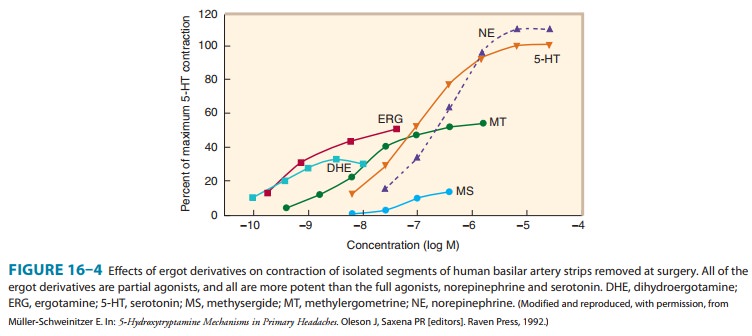Chapter: Basic & Clinical Pharmacology : Histamine, Serotonin, & the Ergot Alkaloids
Basic Pharmacology of Ergot Alkaloids
BASIC PHARMACOLOGY OF ERGOT
ALKALOIDS
Chemistry & Pharmacokinetics
Two
major families of compounds that incorporate the tetracyclic ergoline nucleus may be identified; the
amine alkaloids and thepeptide alkaloids (Table 16–6). Drugs of therapeutic and
toxicologic importance are found in both groups.

The
ergot alkaloids are variably absorbed from the gastrointestinal tract. The
oral dose of ergotamine is about 10 times larger than the intramuscular dose,
but the speed of absorption and peak blood levels after oral administration can
be improved by admin-istration with caffeine . The amine alkaloids are also
absorbed from the rectum and the buccal cavity and after admin-istration by
aerosol inhaler. Absorption after intramuscular injection is slow but usually
reliable. Semisynthetic analogs such as bromocriptine and cabergoline are well
absorbed from the gastrointestinal tract.
The
ergot alkaloids are extensively metabolized in the body. The primary
metabolites are hydroxylated in the A ring, and pep-tide alkaloids are also
modified in the peptide moiety.
Pharmacodynamics
A. Mechanism of Action
The ergot alkaloids act on several types of receptors. As shown by the color outlines in Table 16–6, the nuclei of both catecholamines (phenylethylamine, left panel ) and 5-HT (indole, right panel ) can be discerned in the ergoline nucleus. Their effects include agonist, partial agonist, and antagonist actions at α adrenoceptors and serotonin receptors (especially 5-HT1A and 5-HT1D; less for 5-HT2 and 5-HT3); and agonist or partial agonist actions at central ner-vous system dopamine receptors (Table 16–7). Furthermore, some members of the ergot family have a high affinity for presynaptic receptors, whereas others are more selective for postjunctional receptors. There is a powerful stimulant effect on the uterus that seems to be most closely associated with agonist or partial agonist effects at 5-HT2 receptors. Structural variations increase the selec-tivity of certain members of the family for specific receptor types.
B. Organ System Effects
1. Central nervous system—As indicated by
traditionaldescriptions of ergotism, certain of the naturally occurring
alka-loids are powerful hallucinogens. Lysergic acid diethylamide (LSD; “acid”)
is a synthetic ergot compound that clearly demon- strates this action. The drug has been used in
the laboratory as a potent peripheral 5-HT2antagonist, but good evidence suggests that its behavioral effects
are mediated by agonist effects at
pre-junctional or postjunctional 5-HT2 receptors in the central
ner-vous system. In spite of extensive research, no clinical value has been
discovered for LSD’s dramatic central nervous system effects.
Abuse
of this drug has waxed and waned but is still widespread.
Dopamine receptors in the central nervous system play impor-tant roles in extrapyramidal motor control and the regulation of pituitary prolactin release. The actions of the peptide ergoline bromocriptine on the extrapyramidal system are discussed. Of all the currently available ergot derivatives, bro-mocriptine, cabergoline, and pergolide have the highest selectiv-ity for the pituitary dopamine receptors. These drugs directly suppress prolactin secretion from pituitary cells by activating regu-latory dopamine receptors . They compete for binding to these sites with dopamine itself and with other dop-amine agonists such as apomorphine. They bind with high affinity and dissociate slowly.

2. Vascular smooth muscle—The action of ergot
alkaloids onvascular smooth muscle is drug, species, and vessel dependent, so
few generalizations are possible. In humans, ergotamine and simi-lar compounds
constrict most vessels in nanomolar concentrations (Figure 16–4). The vasospasm is prolonged.
This response is par-tially blocked by conventional α-blocking agents. However, ergot-amine’s
effect is also associated with “epinephrine reversal” and with blockade
of the response to other α agonists. This dual effect reflects the
drug’s partial agonist action (Table 16–7). Because ergotamine dissociates very
slowly from the α
receptor, it produces very long-lasting agonist and antagonist effects at this
receptor. There is little or no effect at β adrenoceptors.

Although
much of the vasoconstriction elicited by ergot alkaloids can be ascribed to
partial agonist effects at α adrenoceptors, some may be the result of
effects at 5-HT receptors. Ergotamine, ergonovine, and methysergide all have
partial agonist effects at 5-HT2 vascular receptors. The remarkably
specific antimigraine action of the ergot derivatives was originally thought to
be related to their actions on vascular serotonin receptors. Current
hypotheses, however, emphasize their action on prejunctional neuronal 5-HT
receptors.
After
overdosage with ergotamine and similar agents, vasos-pasm is severe and
prolonged (see Toxicity, below). This vasospasm is not easily reversed by α antagonists,
serotonin antagonists, or combinations of both.
Ergotamine
is typical of the ergot alkaloids that have a strong vasoconstrictor spectrum
of action. The hydrogenation of ergot alkaloids at the 9 and 10 positions
(Table 16–6) yields dihydro derivatives that have reduced serotonin partial
agonist and vasocon-strictor effects and increased selective α-receptor–blocking
actions.
3. Uterine smooth muscle—The stimulant action
of ergotalkaloids on the uterus, as on vascular smooth muscle, appears to combine
α
agonist, serotonin agonist, and other effects. Furthermore, the sensitivity of
the uterus to the stimulant effects of ergot increases dramatically during
pregnancy, perhaps because of increasing dominance of α1 receptors as pregnancy progresses. As a
result, the uterus at term is more sensitive to ergot than earlier in pregnancy
and far more sensitive than the nonpregnant organ.
In
very small doses, ergot preparations can evoke rhythmic contraction and
relaxation of the uterus. At higher concentrations, these drugs induce powerful
and prolonged contracture. Ergonovine is more selective than other ergot
alkaloids in affecting the uterus and is the agent of choice in obstetric
applications of the ergot drugs although oxytocin, the peptide hormone, is
pre-ferred in most cases.
4. Other smooth muscle organs—In most patients, the
ergotalkaloids have little or no significant effect on bronchiolar or uri-nary
smooth muscle. The gastrointestinal tract, on the other hand, is quite
sensitive. Nausea, vomiting, and diarrhea may be induced even by low doses in
some patients. The effect is consistent with action on the central nervous
system emetic center and on gastro-intestinal serotonin receptors.
Related Topics